Sitting with my coffee and the daily news on one quiet spring morning, I unconsciously kept hearing a strange sound …
“Squeeeek … squeak … squeak … “
Suddenly I realized this was a real sound; I jumped up and began to track down the squeak's source. I stole around the corner, and there, in the middle of my lawn, were Touché and Mona – grazing. They would each bow their heads to the ground and pull with all their might. "Squeak - chomp - chomp. "
I have a beautiful, enormous backyard compared to my tiny triangular front yard. My reward for being the pie end of a cul-de-sac.
I hand-mow the grass for the exercise. It's a great workout. It also makes a great yard for my dogs to play one of their favorite backyard exercises – catch-the-tennis-ball.
I also like to relax with breakfast on the patio next to my swimming pool – owned by the dogs!
I have two ABR-rescued Brittanies; like all Brittanies, they love water and tennis balls – and water and tennis balls.
The reason for the squeak and chomp: The yard was full of six to eight-inch high green swords – scattered throughout the yard. Bamboo shoots. The dogs loved it. But how, what, and from where? It turned out to be from underground stolons of a neighbor's bamboo garden. And they popped up overnight!
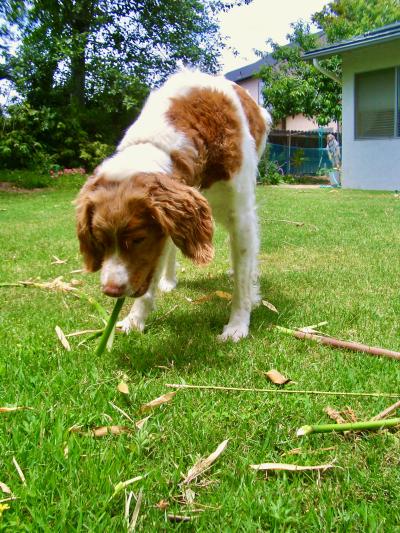
Young bamboo shoots are like sugar cane – sweet and tender, But this episode reminded me of the dangers I could encounter in my own yard. It underscored my need for diligence in keeping the dogs' environment dog friendly.
When my wife and I first purchased our house in this new development, the neighborhood consisted of young couples like us. We all landscaped our yards and ordered the usual yard pest control services. These services spray the yard every three months. I'm sure you know about them.
At that time, I was given a new puppy. The baby Golden Retriever had paws almost as big as his head, so Sasquatch became his name. (This was before I discovered my love of Brittanies.) Sasquatch and I had so much fun playing in the yard, the beach, the forest. One morning in his fourth year, he looked so forlorn and lethargic I immediately smelled trouble. "Daddy, I don't feel well," Sasquatch cried with sadness in his eyes. And his back was depressed, as though he was carrying a heavy load.
The vet exam revealed pancreatic cancer. Immediate surgery was advised. I'll never forget the sad look on his face as they wheeled him into the operating area … sadly, he never came back out.
My wife and I took this event very hard. Although we tried to hypothesize the cause in this pre-information age, until then, we did know that chemical exposure and environment significantly influenced animal disease.
Our discoveries pointed out that we need to provide a safe environment for our children and our animal family members. Both tend to test and taste their new discoveries during their explorations.
The obvious first stop: re-assess our need for blanket yard spraying of poisonous insecticides every three months. Look around. Are you inundated with insects? Flies – okay, let the birds enjoy the meal. Mosquitos – not okay, but spraying the ground won't work, as well as removing stagnant water. Ants – can we handle that on a spot basis as needed? Aphids – soapy water does the job, and it's kinda fun to do that. Caterpillars – if they eat your plants, treat them on the spot; otherwise, let them become butterflies. Roaches – well, that's an inside job.
You get the picture. In most cases, broadcasting generalized chemical killers is, ahem, overkill. And, as your dog grazes your lawn and garden, you don't want them licking up the chemical.
Insecticides are not the only toxic elements to consider. There're household chemicals – cleansers, paints, etc., and fertilizers. Plus, the plants themselves. Many beautiful garden plants are toxic to some degree – from the blossoms, the leaves and stems, the roots, rhizomes, and bulbs.
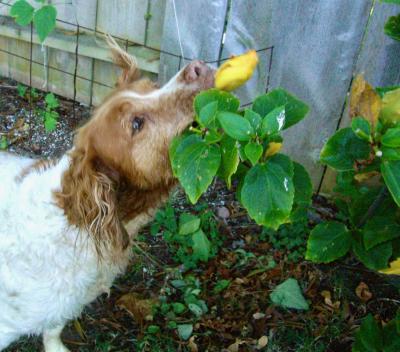 Consider the ability of pets to jump and dig when making sure toxic substances aren't accessible. For example, placing a house plant on top of a bookshelf may not be sufficient if there are cats that like to jump up onto high shelves. Covering fertilizer areas with mulch may be insufficient because dogs can dig and find the fertilizer or bulbs buried beneath. Always err on the side of caution when determining which plants to bring into the house or plant in the yard!
Consider the ability of pets to jump and dig when making sure toxic substances aren't accessible. For example, placing a house plant on top of a bookshelf may not be sufficient if there are cats that like to jump up onto high shelves. Covering fertilizer areas with mulch may be insufficient because dogs can dig and find the fertilizer or bulbs buried beneath. Always err on the side of caution when determining which plants to bring into the house or plant in the yard!
I love Wisteria, for example. I planted one hoping to cover my patio. It did that. Indeed I was rewarded with beautiful, scented blossoms that bumble bees loved. The plant made giant seed pods with a built-in twisting torque that caused them to explode in the dry, hot autumn. Explode they did, throwing their large seeds clear across the yard. Then I was alerted that the seeds were mildly toxic to animals. Fortunately, none of my dogs had any interest in consuming the seeds.
On the other hand, I knew from tragic news events that Oleander was highly fatal. Every part of the plant was poisonous and could cause near-instant death to humans and pets. Obviously, that most beautiful shrub must be ruled out of any place in a yard. In my opinion, their only role is to provide pretty dividers in a highway's median strip.
Another serious no-no is the Sago Palm. It's a pretty plant to decorate a yard or porch. But EVERY PART of the plant is deadly poisonous, and I am told it has no antidote.
It's easy to research and find most plants have some toxic properties but don't let that crimp your style. On the other hand, you want an enjoyable, pretty yard and garden and, yet, not worry about its child and pet friendliness.
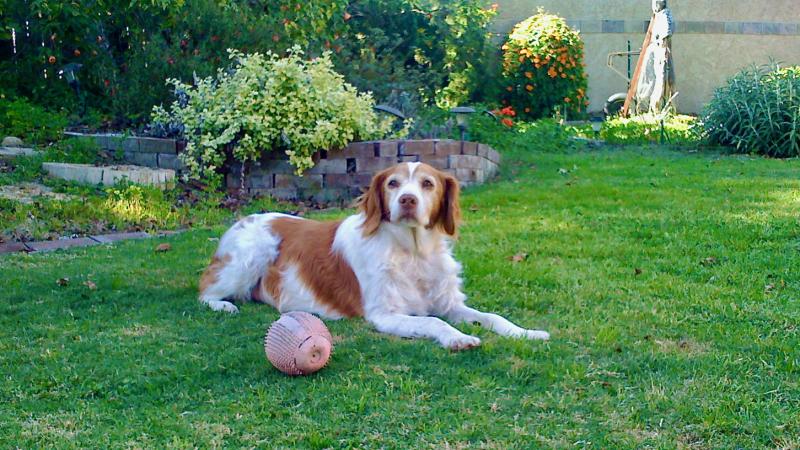
My take on this was to heed the research that pointed out serious, deadly plants. I left them off my planting list. I relegated Some plants that I wanted, like the beautiful Mexican Bird of Paradise, to the front yard where my dogs, if there, would be on leash.
Bottom line: First, plan your yard on paper. Research your plant wish list. Leave off fatally toxic plants. If you really want them where your pets (and children) cannot get to them. Like your front yard or a fenced-in private garden.
Lastly, your swimming pool. If you have one I know you understand child safety rules, but do you know that dogs do drown in pools. And it's not a rare instance. The two main reasons are that the swimmer dog can't find a step-out or cannot swim.
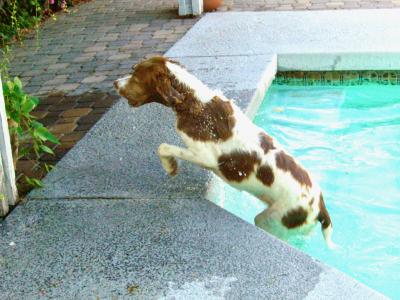
In case of the step-out, it is essential that you spend time showing your pet where it can climb out of the pool – remember, even large dogs cannot grab any side and pull themself out. My neighbor's Miniature Schnauzer passed that way.
One spring morning, I had an exhilarating challenge while having coffee on my patio. I was watching Tango explore his new forever home and surroundings. At about 3 years old, Tango was found wandering California's Mojave desert when ABR rescued him from the pound.
He was investigating the pool while on the far side deck. He held out his paw and leaned over to touch the water. Suddenly, he tried to walk across the pool. I laughed until he went straight to the bottom – and stayed there!
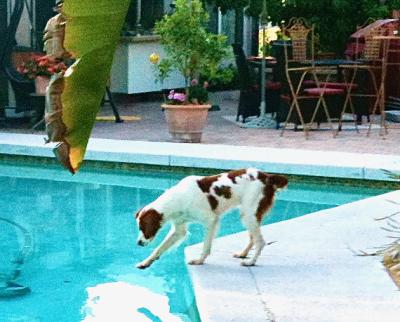 Of course, I immediately jumped, clothes and all, in and grabbed him. Fortunately, it was the shallow side. With my hands holding up his stomach, I expected him to dog-paddle. While he flared his front legs, I let go. He immediately began to sink. It took a lot of patience, but he finally showed his excitement in water, which I assumed was in the genes of all Brittanies.
Of course, I immediately jumped, clothes and all, in and grabbed him. Fortunately, it was the shallow side. With my hands holding up his stomach, I expected him to dog-paddle. While he flared his front legs, I let go. He immediately began to sink. It took a lot of patience, but he finally showed his excitement in water, which I assumed was in the genes of all Brittanies.
So, before going out to dinner and theater the day you adopt your new love, ensure he will be safe and sound alone in his new environment.
####

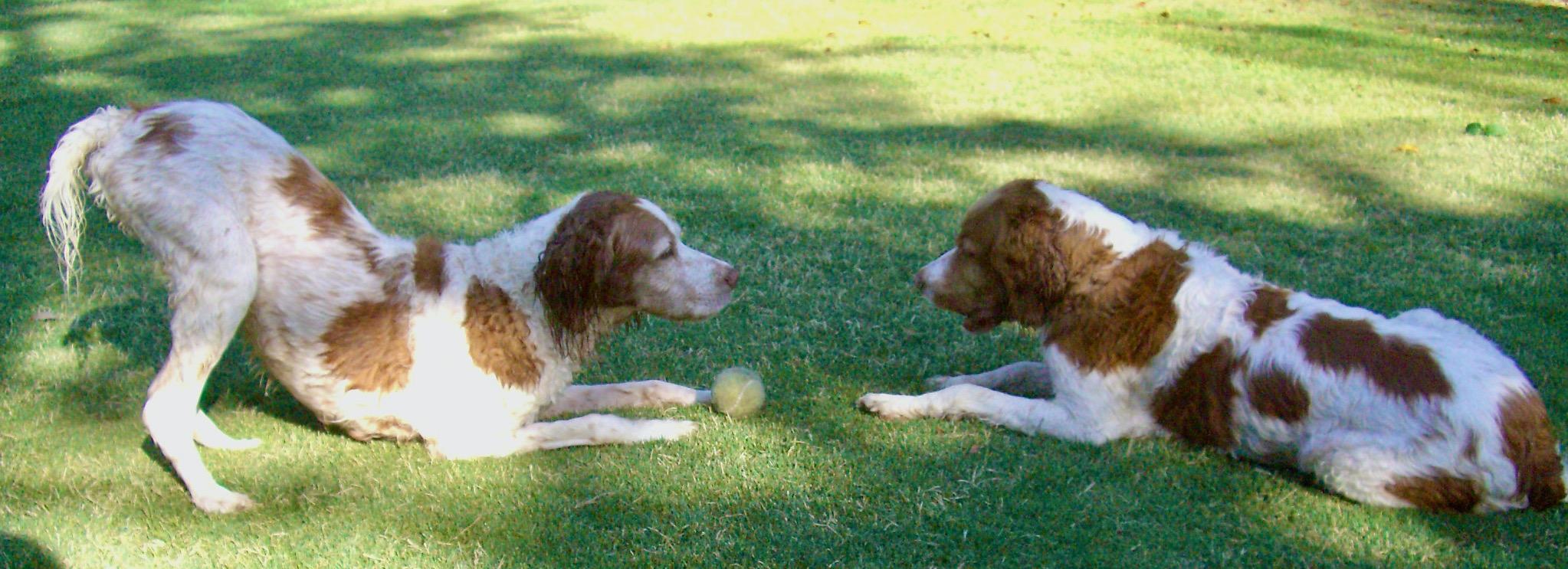
Please leave a comment …
Add a comment